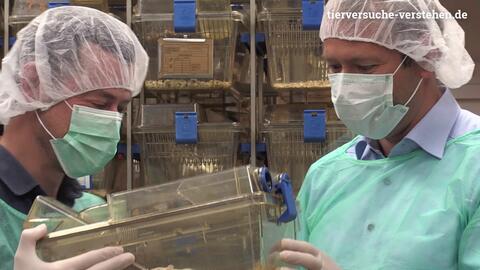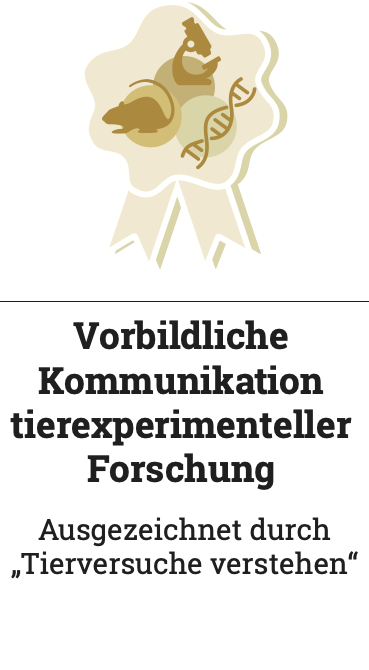
Our laboratory animals
Good science and good animal welfare practices go hand in hand
For good preclinical science it is a basic prerequisite that laboratory animals are kept in good conditions. This is because if animals are suffering or under stress when they are used in an experiment, the results may be distorted, they are no longer “valid”. For example, distress is accompanied by an increased production of certain hormones, which can affect the blood pressure and metabolism of the animals.

Video from the information initiative “Tierversuche verstehen”
The animal welfare officers and experienced animal keepers immediately recognize whether for example a mouse is fine. They regularly check the transparent cages. A drinking bottle hangs down from above, a red box in a corner of the cage offers space to hide. Did they build a nice closed nest out of hemp? That would be a sign of well-being.
The most important questions and answers
- Which types of animals do we use in our research?
-
Scientists at the Max Delbrück Center work primarily with mice, rats, zebrafish and naked mole rats. Experiments are also conducted on other organisms such as fruit flies, flatworms and nematode worms, but these are not considered animal experiments as the subjects are not vertebrates.
-
The Max Delbrück Center mainly breeds and keeps mice, but also rats, zebrafish and naked mole rats. A few rabbits are kept at the Max Delbrück Center for the extraction of antibodies. A very small number of guinea pigs, hamsters and rabbits are kept for the training of the animal keepers.
At the Max Delbrück Center, genetically modified mice serve as models for Alzheimer’s disease or for tumor development. Rats are mainly used for cardiovascular research, and zebrafish as a model for common developmental disorders of the heart. The naked mole rate is decidedly more difficult to keep, and is primarily used at the Max Delbrück Center to help study the mechanisms by which pain develops.
The Max Delbrück Center also investigates special biological abilities that animals possess but humans lack, in an effort to understand and learn from them. People who suffer a stroke, for example, usually suffer permanent damage due to the associated oxygen deprivation. Naked mole rats, however, can go for a long time without oxygen and suffer no damage at all. Zebrafish hearts, meanwhile, are able to repair themselves – which would be helpful for people suffering from heart disease.
- How are the animals kept?
-
The Max Delbrück Center has three buildings for housing animals and conducting preclinical research. The animals are cared for by six animal welfare officers and about a hundred animal facilities employees.
-
The Max Delbrück Center has three animal facilities that house some 55,000 mice and 2,500 rats. As mice are social animals, they are kept in groups. An average of three to a maximum of six adult mice live in each of the approximately 17,400 cages, with the size of the group determined by the weight of the animals. The most commonly used cages for mice at the Max Delbrück Center are approximately 37 x 16 cm plexiglass boxes, containing bedding, nesting and play materials. The rat cages have the same contents, but are significantly larger and have higher walls. There are just over 1,000 rat cages at the Max Delbrück Center.
Staff at the animal facilities clean the cages weekly, ensure the animals always have sufficient water and food, and check the health condition of the animals every day – including on weekends and during holidays. A mouse can live up to three years in these conditions, whereas life expectancy in the wild is about six months.
Six full-time animal welfare officers, who are trained veterinarians, provide health care for all of the laboratory animals and make sure that all animal experiments are conducted correctly from an animal welfare standpoint.
The temperature, humidity, and the light-dark rhythm of the rooms in which the cages are located are kept constant throughout the year. The cages are ventilated to ensure the animals do not come into contact with any pathogens. This means that filtered air circulates inside the cages and the ventilation system is sealed off from the outside. In addition, all food, litter, water, and anything else that the animals need is sterilized before it enters the animal facilities. Everyone who enters these facilities must also put on sterile clothing. All procedures performed on the animals – such as the taking of blood, ultrasound examinations, or injections – are performed under laboratory conditions. This so-called barrier system for keeping animals requires high-tech equipment and sophisticated building technology. Our animal facilities are continuously adapted to meet the most modern standards. This applies to the technical equipment, hygiene conditions, and the training of animal keepers and scientists who work there.
Conditions for keeping and looking after these animals – such as the size and design of cages and number of animals to a cage – are regulated by Directive 2010/63/EU. The compliance of the Max Delbrück Center with legal regulations is constantly monitored by the center’s six animal welfare officers. The center’s animal facilities are also inspected several times a year by the regulatory authority, the Berlin State Office for Health and Social Affairs (LaGeSo).
- What sort of procedures are performed on laboratory animals at the Max Delbrück Center?
-
-
The statistics provided by the Federal Ministry of Food and Agriculture (BMEL) record not only the number of animals used, but also the level of pain, suffering or distress they experience. All procedures performed on animals during the reporting period are recorded. According to the statistics, almost half of all animal tests performed at the Max Delbrück Center in 2018 (48.4 percent) involved low levels of pain, suffering or distress – i.e., either blood was taken or they were examined via magnetic resonance imaging (MRI). A good 40 percent of the animals were put to death in 2018 in order to obtain tissue samples or entire organs – i.e., to create tissue cultures. Every tenth procedure exposed the animals to a moderate level of pain, suffering or distress. This category includes interventions such as the surgical implantation of a sensor into the chest of a mouse in order to continuously measure its heart rate. The “severe” category covers surgical procedures that are intended to make animals sick – i.e., operating on the heart in order to restrict its function. In 2018, experiments on 348 animals (0.7 percent) were classified as likely to cause severe pain, suffering or distress.
- How can you tell if laboratory animals are suffering?
-
The signs of suffering in animals can vary greatly from one species to the next. Some animals change their facial expression or move less, while others lose weight or display different social behavior.
-
The apparent suffering of animals looks very different from one species to the next. Just like cats, mice lay their whiskers flat and they display a characteristic facial expression. They also move less. Naked mole rats, meanwhile, lose weight, isolate themselves, and their sensitive skin becomes dry. Interpreting these signs correctly requires training. Therefore, all scientists who wish to conduct animal experiments at the Max Delbrück Center must first learn to recognize pain, suffering and distress in animals in the mandatory Lab Animal Science course (20 hours of practical work; 20 hours of theory). In addition, the animal welfare officers regularly offer further training courses on how to tell if an animal is experiencing pain.
The animal keepers monitor the state of health and well-being of the animals on a daily basis, including weekends and holidays. The animal welfare officers, the veterinarians, support them in this. They also supervise that all animal experiments are carried out in accordance with animal protection regulations.
The Max Delbrück Center supports the Basel Declaration
All signatories of the Basel Declaration on animal research, which was passed in November 2010, have agreed to uphold ethical standards and promote greater transparency and communication on animal research. The Max Delbrück Center signed the Declaration in 2012.
The Max Delbrück Center supports the European directive on the protection of laboratory animals
Directive 2010/63/EU on the protection of animals used for scientific purposes became law in November 2010. The Max Delbrück Center supports the Directive as it improves animal welfare standards across Europe. It compels researchers to replace animal experiments with other methods where possible, to reduce the number of laboratory animals, and to refine their experiments. “Refining” includes, for example, choosing methods that minimize animals’ pain and suffering. The Directive sets minimum standards for the housing and care of laboratory animals, prescribes regular inspections, and requires researchers to publish descriptions of experiments in terms that laypeople can understand.
In March 2015, the Max Delbrück Center and many other European research institutions published a statement in support of the Directive.
Research, animal experiments and the 3Rs
Why animal research?
Why we cannot yet avoid animal testing
Our laboratory animals
PRC Preclinical Research Center
The 3R principles
Research without animal experiments
Mini-organ, mathematical model or mouse?
Facts and figures
Approval and monitoring
Transparent communication

